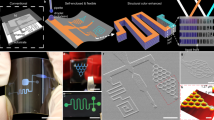Abstract
Electrofluidic displays were first reported in 2009, and transpose brilliantly colored pigment dispersions via competition between electromechanical and Young-Laplace pressure. To our knowledge, this is the first display technology to use a three-dimensional (3-D) microfluidic device structure and leverages brilliantly colored aqueous pigment dispersions. Reported herein is a brief review of electrofluidic display technology. The review includes the device operating principle, fabrication, speed, brightness, and color performance. Also presented is recent progress in key areas needed for realizing products, including bistability, fabrication on flexible substrates, and performance in various temperatures (varied from −28 °C to 80 °C).
Similar content being viewed by others
Abbreviations
- C:
-
Capacitance
- CMY:
-
Cyan, magenta and yellow
- d:
-
Dielectrics thickness
- DPI:
-
Dots per inch
- h:
-
Channel height
- l:
-
Pixel length
- p:
-
Pressure
- R :
-
Radius of curvature
- R:
-
Reflectance
- RGB(W):
-
Red, green, blue (white)
- U:
-
Velocity
- V:
-
Voltage
- γ:
-
Interfacial surface tension
- ε:
-
Dielectric constant
- θV :
-
Wetting angle under voltage
- θY :
-
Young’s angle
References
Back U et al (2002) Nanomaterials-based electrochromics for paper-quality display. Adv Mater 14:845–848
Berthier J (2008) Microdrops and digital microfluidics. William and Andrew, New York
Brown EC et al (2005) Adding a white subpixel. Inf Disp 5:26–31
Cristea D, Vilarem G (2006) Improving light fastness of natural dyes on cotton yarn. Dyes Pigm 70:238–245
Fair R (2007) Digital microfluidics: is a true lab-on-a-chip possible? Microfluid Nanofluid 3:245–281
Graham-Rowe D (2008) Electronic paper targets colour video. Nat Photonics 2:204–205
Hagedon M, Yang S, Russell A et al (2012) Bright e-Paper by transport of ink through a white electrofluidic imaging film. Nat Commun 3:1173, 11/06/online
Hattori R et al (2004) A novel bistable reflective display using quick-response liquid powder. J Soc Inf Disp 12:75–80
Hayes RA, Feenstra BJ (2003) Video-speed electronic paper based on electrowetting. Nature 425:383–385
Heikenfeld J et al (2009) Electrofluidic displays using Young-Laplace transposition of brilliant pigment dispersions. Nat Photonics 3:292–296
Huitema E et al (2006) Flexible electronic-paper active-matrix displays. J Soc Inf Disp 14:729–733
Jones TB (2005) An electromechanical interpretation of electrowetting. J Micromech Microeng 15:1184–1187
Khan A et al (2005) Reflective cholesteric LCDs for electronic paper applications. In: Proceedings of the international display manufacturing conference, pp 397–399
Mugele F, Baret J (2005) Electrowetting: from basics to applications. J Phys Condens Matter 17:R705–R774
Song J et al (2009) A scaling model for electrowetting-on-dielectric microfluidic actuators. Microfluid Nanofluid 7:75–89
Yang S et al (2010) High reflectivity electrofluidic pixels with zero-power grayscale operation. Appl Phys Lett 97(143501):3
Zhou K et al (2010a) Reliable electrofluidic display pixels without liquid splitting. SID 10 Digest, pp 1659–1662
Zhou K et al (2010b) Flexible electrofluidic displays using brilliantly colored pigments. SID 10 Digest, pp 484–486
Further Reading
Heikenfeld J et al (2011) Review paper: a critical review of the present and future prospects for electronic paper. J Soc Inf Disp 19(2):129–156
Zhou K et al (2009) A full description of a simple and scalable fabrication process for electrowetting displays. J Micromech Microeng 19(065029):12
Author information
Authors and Affiliations
Corresponding author
Editor information
Editors and Affiliations
Rights and permissions
Copyright information
© 2015 Springer-Verlag Berlin Heidelberg
About this entry
Cite this entry
Heikenfeld, J., Zhou, K. (2015). Electrofluidic Displays. In: Chen, J., Cranton, W., Fihn, M. (eds) Handbook of Visual Display Technology. Springer, Berlin, Heidelberg. https://doi.org/10.1007/978-3-642-35947-7_105-2
Download citation
DOI: https://doi.org/10.1007/978-3-642-35947-7_105-2
Received:
Accepted:
Published:
Publisher Name: Springer, Berlin, Heidelberg
Online ISBN: 978-3-642-35947-7
eBook Packages: Springer Reference EngineeringReference Module Computer Science and Engineering




